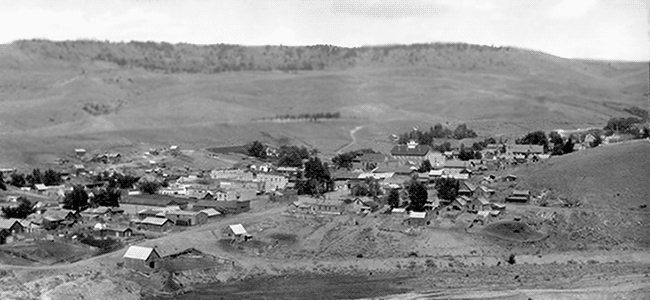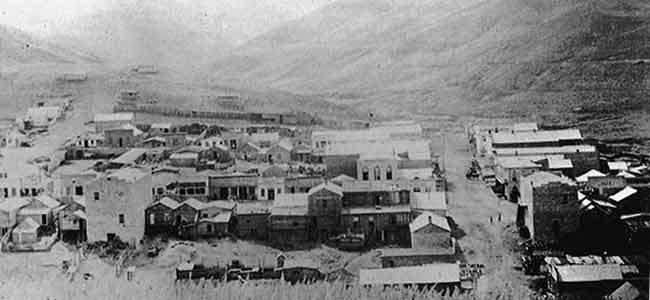History of Alder Gulch
Virginia City and Nevada City lie along Alder Gulch, the site of the richest placer gold strike in the Rocky Mountains with an estimated total value of 100 million dollars throughout the 18th and 19th century. In the early 1860s, during the first three seasons, an estimated $30 million worth of gold was removed from the gulch. In the following years, gold was extracted from placer as well as lode mines.


From 1848 through the 1860s Alder Gulch was part of a broad expansion of mining from California into many parts of Western North America. The western gold rushes of the 1860s led Congress to create five new territories. Experienced miners traveled to the successive mining frontiers, bringing with them mining technology and social traditions. Alder Gulch was in Idaho Territory until May 1864, when the Montana Territory was created. Bannack was the site of the first placer gold strike within the Montana territory in 1862 and shortly thereafter became the first territorial capital.
The Discovery
On May 26, 1863, Barney Hughes, Thomas Cover, Henry Rodgers, William Fairweather, Henry Edgar and Bill Sweeney camped along a small stream fringed with alder trees. Fairweather and Edgar went to prospect a place of rimrock. Fairweather dug the dirt, filled a pan and told Edgar to wash the pan in the hope of getting enough gold to buy tobacco. When the first pan turned up $2.40, they knew the gulch had great potential.
Word spread like wildfire. Miners covered the hillsides with tents, brush shelters and crude log cabins. On June 16, the Varina Town Company platted the town. Supporters of Jefferson Davis and the Confederacy, intended to name the new town after Jefferson Davis' wife, Varina. However, Dr. G. G. Bissell, the newly elected miners' court judge, was an equally stubborn Unionist. When it came time to file the official documents, he submitted the name Virginia instead.
Virginia City was designated as the new territorial capital of Montana in 1865 when Alder Gulch had gathered most of Montana's population. At its peak, 10,000 people flooded the area named "Fourteen-mile City" for the numerous settlements that lined the gulch. Virginia City became the largest settlement with an estimated population of 5,000 by mid-1864. It rapidly became the territory's first social center and transportation hub.
For the first several years of placer mining along Alder Gulch, miners used hand tools such as sluice boxes to separate the gold from the gravels. In 1867, hydraulic was introduced to the area. Jets of pressurized water washed down the dirt, leaving behind piles of rocks and hydraulic cuts. The timber on the surrounding hillsides was clear-cut to provide building materials, mine timber, and fuel. From 1898 through 1922, large floating dredges chewed up the ground, destroying several communities in their path and leaving behind distinctive tailings and dredge ponds as far upstream as Virginia City. Smaller dryland dredges returned to the gulch in the 1930s, after a rise in the price of gold. The town of Virginia City itself, unlike many other mining communities, was never dug up and destroyed because it had not been established on top of gold-bearing gravels. All of the original town of Nevada City west of the Highway was eradicated by dredging operations in the early 1900s. Today many historic cabins have been moved to the site where Nevada City once existed. You can get an idea of what it would have been like to live in the Alder Gulch area during the 1860s by visiting the Nevada City Museum on weekends during the summer months where daily life is reenacted through the Living History program.
Lode mining in the upper section of Alder Gulch began at the community known as Summit. A number of mills concentrated ore from these mines in the 1860s and 1870s. Lode mining was never as productive as placer mining but it was somewhat revitalized in the years following 1881, due to the arrival of a railroad to Montana; the introduction of improved milling processes; and an increased demand for silver. By 1910 most of the lode claims were being worked by small crews of leasers. A branch-line railroad reached Alder in 1901, but it did not extend the additional ten miles to Virginia City because the tracks would have interfered with the dredging operations underway at that time. Lode mining revived again in the 1930s when the price of gold rose significantly. All mining for gold in Alder Gulch closed down temporarily in 1942, however, because of a war-time prohibition on gold mining.
The mining activity along Alder Gulch had far-reaching effects. It stimulated the formation of government on all levels, the increase in settlement and use of the northern Rockies, and the evolution of regional transportation systems. Gold from Alder Gulch contributed to the national economy both during and after the Civil War. The town of Virginia City moved quickly through the phases of settlement, camp, and town, having around 5,000 inhabitants at its peak. These phases encompassed tents, log cabins, vernacular frame buildings, and commercial buildings with false fronts, plus (at least in Virginia City) high-style residences and commercial buildings. Substantial business blocks reflected the residents' belief in the permanence of the mining district and the towns along Alder Gulch. The layered remnants of each phase are evident in the buildings that remain today. Remodeling, additions and other modifications bear witness to the town's unfolding history.
Virginia City served as the hub of a vast transportation network until 1875, with supplies coming in from Salt Lake City, Portland, Omaha, and Fort Benton. The "Social City" was also the cultural focal point of the territory. The population of Alder Gulch was diverse in the early years, including Euroamericans, Chinese (in 1870, about one third of the residents of Virginia City were Chinese), Lemhi Shoshone Indians, Mexicans, and African Americans. The community remained a service center until the 1880s. While many of the miners may not have struck it rich, some of the merchants did attain financial rewards from their time at Alder Gulch. A wide variety of businesses clustered along lower Wallace Street and South Jackson Street, and residences were built along Idaho Street and on the South slopes. In 1868, Virginia City had some 1,200 buildings (it has 237 major structures today). Social organizations flourished. A number of newspapers were published out of Virginia City over the years, and several schools were established. In 1866, Virginia City became the first town in Montana to get a telegraph.
The discovery of gold in Last Chance Gulch (Helena) in the summer of 1864 foretold the coming decline of Virginia City. Many residents soon moved to Helena. Virginia City's population collapsed to only a few hundred in the early 1870s and never recovered. In 1875, the territorial capital was relocated to Helena. After 1900, few new buildings were constructed in Virginia City and many old structures collapsed. Some were destroyed by fire or torn down.
Interest in preserving and memorializing the history of Virginia City solidified in 1899 at an annual meeting of the Montana Historical Society. Henry Edgar, one of the discoverers of gold at Alder Gulch, led a crowd to the site where the first gold had been found. In 1907, the graves of the five road agents buried on Boot Hill were exhumed, identified, and reburied, and new headboards were erected. More tourists began to make their way to Virginia City in the 1920s, as the popularity of automobiles grew. The Thompson-Hickman Museum was built in 1918 and the Vigilance Club, founded in 1938, maintains the collection. In 1928, a massive marble marker was placed at the discovery site. Rank's Drug in Virginia City housed a drugstore museum for many years. In 1937, just two years after Congress assigned the National Park Service responsibility for surveying historic properties of national significance, that agency prepared a report on Virginia City that concluded that the town warranted consideration of national recognition. At that time, some 6,500 visitors came to the community each summer.
Today, Virginia City is considered the best preserved example of the many placer mining camps that flourished during the 1860s throughout the Rocky Mountain West. It provides an exceptional sample of commercial architecture of the mid-nineteenth century. The greatest concentration of historic buildings dates to the 1870s, but some of the buildings' later modifications also have historical significance. Virginia City today has approximately 150 year-round residents and about 300 summer residents. It sits at an elevation of 5,680 feet, in a bowl along the edge of Alder Gulch. Approximately 500,000 visitors come through Virginia City annually.
Help preserve this great historic site by becoming a member, donating, or volunteering today.
More historic information is available through these web sites:
- Legends of America
- Montana Historical Society
- Montana: Stories of the Land
- Virginia City website (includes list of books on the area)
- Wikipedia Montana Timeline

